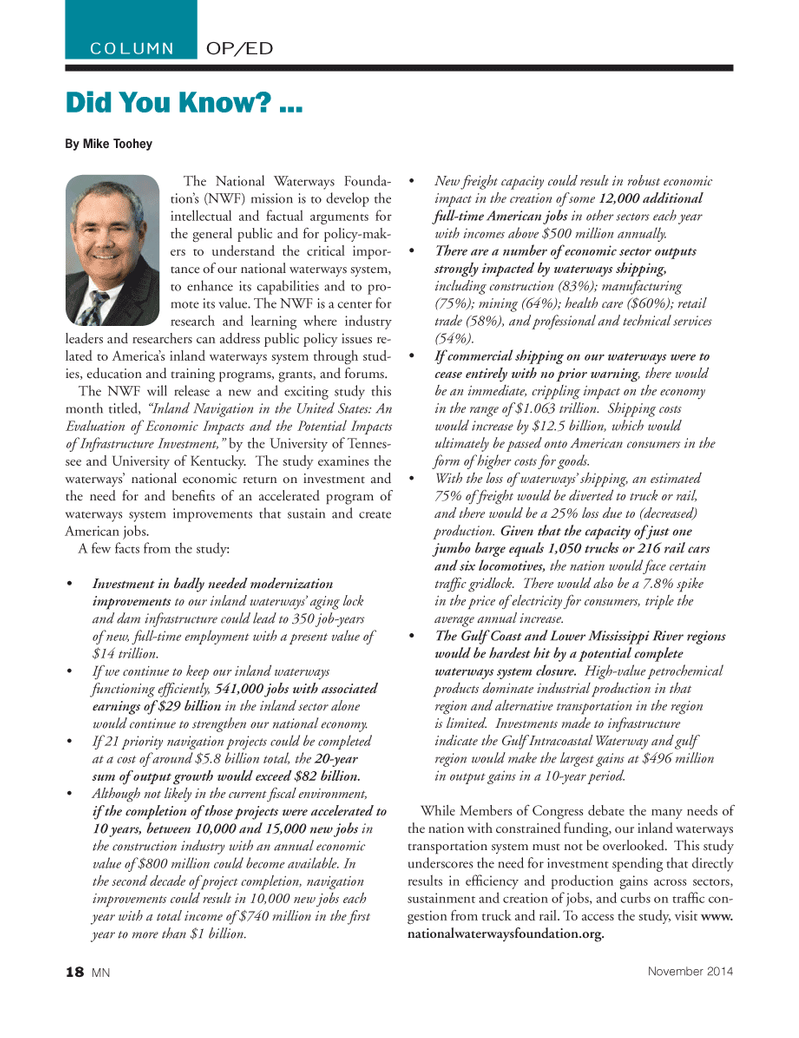
Page 18: of Marine News Magazine (November 2014)
Workboat Annual
Read this page in Pdf, Flash or Html5 edition of November 2014 Marine News Magazine
The National Waterways Founda- tion’s (NWF) mission is to develop the intellectual and factual arguments for the general public and for policy-mak- ers to understand the critical impor- tance of our national waterways system, to enhance its capabilities and to pro- mote its value. The NWF is a center for research and learning where industry leaders and researchers can address public policy issues re- lated to America’s inland waterways system through stud- ies, education and training programs, grants, and forums.
The NWF will release a new and exciting study this month titled, “Inland Navigation in the United States: An
Evaluation of Economic Impacts and the Potential Impacts of Infrastructure Investment,” by the University of Tennes- see and University of Kentucky. The study examines the waterways’ national economic return on investment and the need for and benefi ts of an accelerated program of waterways system improvements that sustain and create
American jobs.
A few facts from the study: Investment in badly needed modernization improvements to our inland waterways’ aging lock and dam infrastructure could lead to 350 job-years of new, full-time employment with a present value of $14 trillion. If we continue to keep our inland waterways functioning effi ciently, 541,000 jobs with associated earnings of $29 billion in the inland sector alone would continue to strengthen our national economy. If 21 priority navigation projects could be completed at a cost of around $5.8 billion total, the 20-year sum of output growth would exceed $82 billion. Although not likely in the current fi scal environment, if the completion of those projects were accelerated to 10 years, between 10,000 and 15,000 new jobs in the construction industry with an annual economic value of $800 million could become available. In the second decade of project completion, navigation improvements could result in 10,000 new jobs each year with a total income of $740 million in the fi rst year to more than $1 billion. New freight capacity could result in robust economic impact in the creation of some 12,000 additional full-time American jobs in other sectors each year with incomes above $500 million annually. There are a number of economic sector outputs strongly impacted by waterways shipping, including construction (83%); manufacturing (75%); mining (64%); health care ($60%); retail trade (58%), and professional and technical services (54%). If commercial shipping on our waterways were to cease entirely with no prior warning, there would be an immediate, crippling impact on the economy in the range of $1.063 trillion. Shipping costs would increase by $12.5 billion, which would ultimately be passed onto American consumers in the form of higher costs for goods. With the loss of waterways’ shipping, an estimated 75% of freight would be diverted to truck or rail, and there would be a 25% loss due to (decreased) production. Given that the capacity of just one jumbo barge equals 1,050 trucks or 216 rail cars and six locomotives, the nation would face certain traffi c gridlock. There would also be a 7.8% spike in the price of electricity for consumers, triple the average annual increase. The Gulf Coast and Lower Mississippi River regions would be hardest hit by a potential complete waterways system closure. High-value petrochemical products dominate industrial production in that region and alternative transportation in the region is limited. Investments made to infrastructure indicate the Gulf Intracoastal Waterway and gulf region would make the largest gains at $496 million in output gains in a 10-year period.
While Members of Congress debate the many needs of the nation with constrained funding, our inland waterways transportation system must not be overlooked. This study underscores the need for investment spending that directly results in effi ciency and production gains across sectors, sustainment and creation of jobs, and curbs on traffi c con- gestion from truck and rail. To access the study, visit www. nationalwaterwaysfoundation.org.
OP/EDCOLUMN
Did You Know? ...
By Mike Toohey 18 MN
November 2014
MN Nov14 Layout 18-31.indd 18 10/23/2014 10:22:19 AM

 17
17

 19
19
